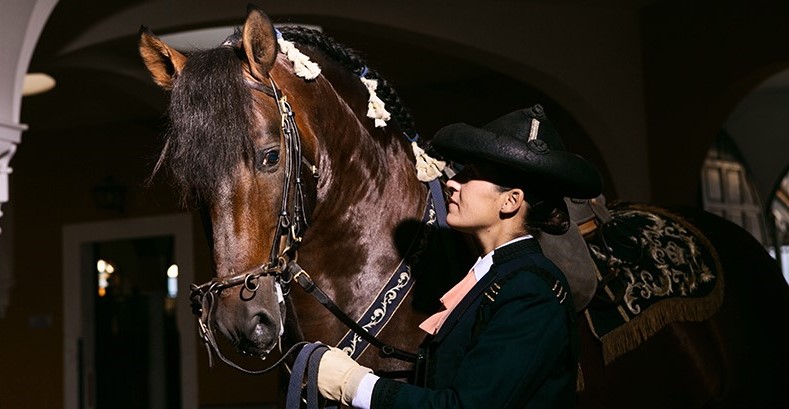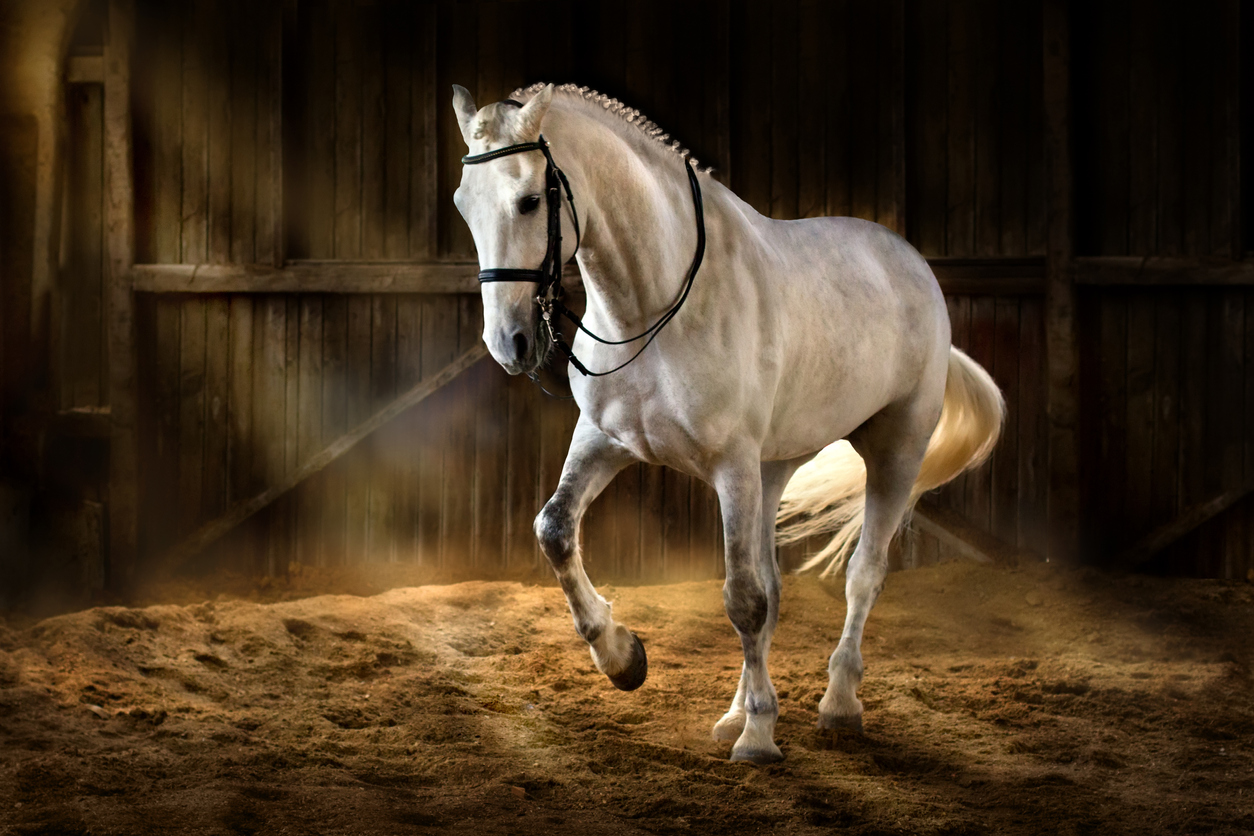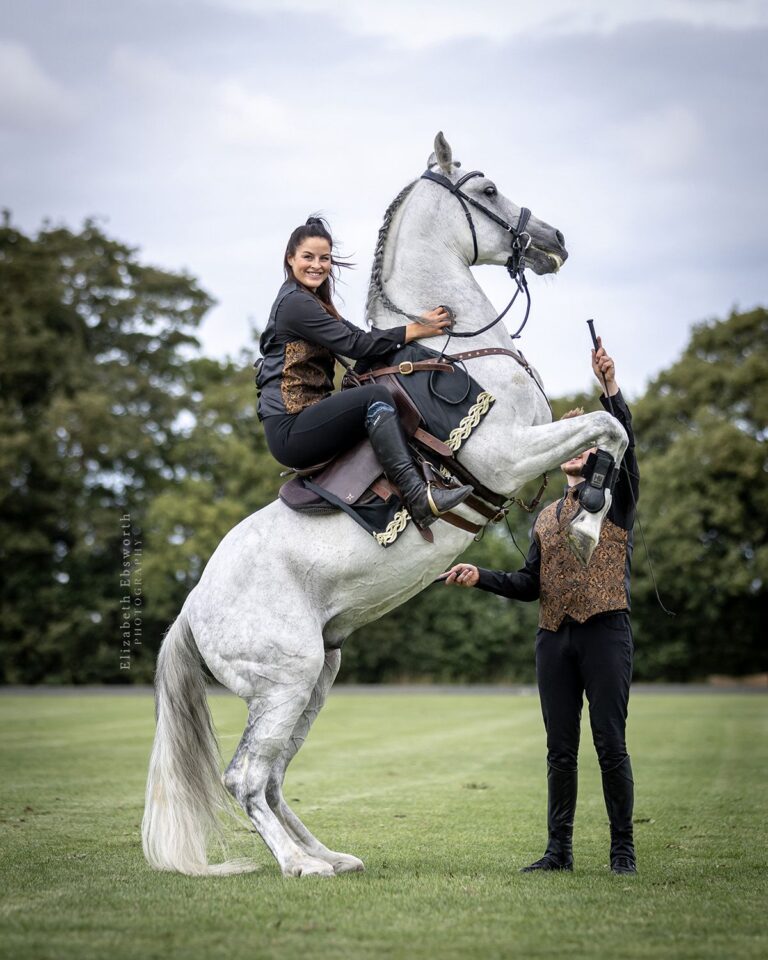
La región andaluza de España ha albergado caballos excepcionales durante más de cinco siglos. El Caballo Pura Raza Española se desarrolló aquí y se convirtió en un caballo muy codiciado por la nobleza europea por su inteligencia, capacidad atlética y temperamento apacible.
La historia de los caballos andaluces es, en definitiva, una historia de supervivencia y adaptación. Desde las pinturas rupestres prehistóricas hasta las competiciones olímpicas modernas, estos caballos han mantenido su carácter esencial adaptándose a los nuevos tiempos. Si bien su número es reducido, con menos de 60.000 ejemplares en todo el mundo, su influencia en la cultura ecuestre mundial sigue siendo profunda.
Desde la doma clásica en el reconocido espectáculo de la Real Escuela Andaluza «Cómo Bailan los Caballos Andaluces», hasta galopar por las playas o pastar tranquilamente en los prados, estos caballos representan diferentes significados para cada persona: una conexión cultural, una herencia familiar, un estilo de vida apreciado o un recuerdo cinematográfico entrañable.

La raza del caballo andaluz se originó en la Península Ibérica, donde sus ancestros han vivido durante miles de años. Pinturas rupestres de entre el 20.000 y el 30.000 a. C. muestran caballos probablemente emparentados con las razas ibéricas modernas, e incluso Homero menciona a los caballos ibéricos en la Ilíada por su legendaria calidad.
El nombre formal es P.R.E. (Pura Raza Española) surgió en 1567 con el programa de cría del rey Felipe II. Para el siglo XVI, los caballos españoles eran considerados los mejores del mundo y llegaron a ser conocidos como el «caballo real de Europa», y William Cavendish, duque de Newcastle, se refería a ellos como los «príncipes» del mundo ecuestre.
Los monjes cartujos desempeñaron un papel crucial, conservando algunos de los primeros pedigríes escritos de Europa del siglo XIII y estableciendo granjas de cría en Jerez, Sevilla y Cazalla a finales del siglo XV. Estos monjes mantuvieron linajes con una pureza notable que se mantiene hasta nuestros días.

La Real Escuela Andaluza de Equitación: La España Moderna continúa preservando su patrimonio ecuestre a través de prestigiosas instituciones como las escuelas de equitación tradicionales, donde el antiguo arte de la doma clásica se mantiene vibrantemente vivo. Estas escuelas funcionan como «universidades de doma», con estudiantes residentes que estudian durante cuatro años junto con visitantes internacionales que asisten a cursos intensivos de días o semanas.
Con más de 117 caballos, decenas de estudiantes y maestros artesanos que crean todos los arneses, sillas de montar y bridas in situ utilizando técnicas inalteradas desde el siglo XVIII, estas instituciones representan museos vivientes de la cultura ecuestre española. Sus espectáculos muestran desde la tradicional monta vaquera española a una mano hasta la doma clásica y los espectaculares enganches, culminando con el carrusel, un ballet coreografiado donde caballos y jinetes se mueven en perfecta armonía.
Como explica un jinete: «El caballo español tiene casi 500 años de historia… cuando alguien se sube a uno de estos caballos, se enamora para siempre». Estas escuelas no sólo preservan tradiciones centenarias a nivel local, sino que también realizan giras internacionales, compartiendo el arte ecuestre de España con el mundo.

El atractivo de los caballos andaluces trasciende las escuelas de equitación tradicionales y se extiende al entretenimiento moderno y a la cultura ecuestre global. Estos caballos, conocidos como «caballos bailarines», se han convertido en estrellas de la gran pantalla, con entrenadores talentosos como Oliver Phillips en Inglaterra, que utilizan sementales de PRE para el cine; uno de ellos realizó la espectacular cabriola en la serie de televisión «El Señor de los Anillos».
Presentes actualmente en más de 65 países, estos caballos, con un promedio de 15 a 17 manos* y su característico color gris y castaño, siguen cautivando tanto a jinetes como al público.
*»Manos» es una unidad de medida tradicional para la altura del caballo. Una mano equivale a 4 pulgadas (10,16 cm), por lo que:
15 manos = 60 pulgadas = 152 cm
17 manos = 68 pulgadas = 173 cm
La Real Asociación de Criadores de Caballos de Pura Raza Española capta a la perfección su esencia: «Estas ventajas pasan desapercibidas a primera vista; aparecen al entrar en contacto con el caballo, cuando jinete y caballo se convierten en uno». Los jinetes modernos los describen como «ese caballo icónico de ensueño» con crines ondulantes y una cualidad casi mágica: caballos que «no te dejan solo» y en los que puedes confiar plenamente porque «están realmente contigo».
 Experimentando la herencia ecuestre andaluza en Marbella Club Hills
Experimentando la herencia ecuestre andaluza en Marbella Club HillsPara quienes buscan conectar con esta rica tradición ecuestre, el Centro Ecuestre Marbella Club, dentro del Marbella Club Golf Resort, ofrece una auténtica ventana a la cultura ecuestre española. Las instalaciones cuentan con pistas mantenidas por profesionales, ideales tanto para la equitación recreativa como para el entrenamiento profesional, con caballos cuidadosamente seleccionados que incluyen tanto monturas mansas para principiantes como animales vivaces para jinetes experimentados.
La instrucción profesional combina las técnicas tradicionales de la equitación española con métodos internacionales modernos, permitiendo a jinetes de todos los niveles experimentar esta centenaria relación entre el caballo y el ser humano. Los senderos de montaña ofrecen el entorno perfecto para comprender por qué los caballos españoles desarrollaron su legendaria seguridad y temperamento tranquilo.
Ubicado en la finca de La Zagaleta, el club hípico está considerado un centro ecuestre de primera clase. Rezuma el encanto de una elegante casa de campo en un entorno tranquilo y verde. El club cuenta con instalaciones de primera clase, que incluyen 20 cuadras, seis paddocks y una zona cubierta para entrenamiento, doma y saltos.
El ambiente del club hípico transporta a los visitantes al ambiente típico de la Costa del Sol, ofreciendo una experiencia que evoca la tranquilidad de una finca cerca de Sevilla. El club ofrece entrenamiento experto adaptado a diferentes niveles, dirigido a niños, adultos, principiantes y jinetes avanzados que aspiran a competir. Bajo la dirección del Sr. Alfonso Espósito, el dedicado personal garantiza que montar a caballo en La Zagaleta siga siendo una actividad placentera, posicionándola como una de las mejores opciones de estilo de vida de La Zagaleta.
La vida en La Zagaleta es sinónimo de lujo, exclusividad y un fuerte sentido de comunidad. Familias, niños y residentes disfrutan de un estilo de vida que combina privacidad, seguridad y una gran variedad de opciones de ocio. Desde una excelente educación hasta las maravillas de la naturaleza, La Zagaleta ofrece un entorno excepcional donde las familias pueden prosperar y crear recuerdos para toda la vida.
Recibe actualizaciones exclusivas sobre propiedades, tendencias del mercado y consejos directamente en tu correo. ¡Sé el primero en descubrir las mejores oportunidades!